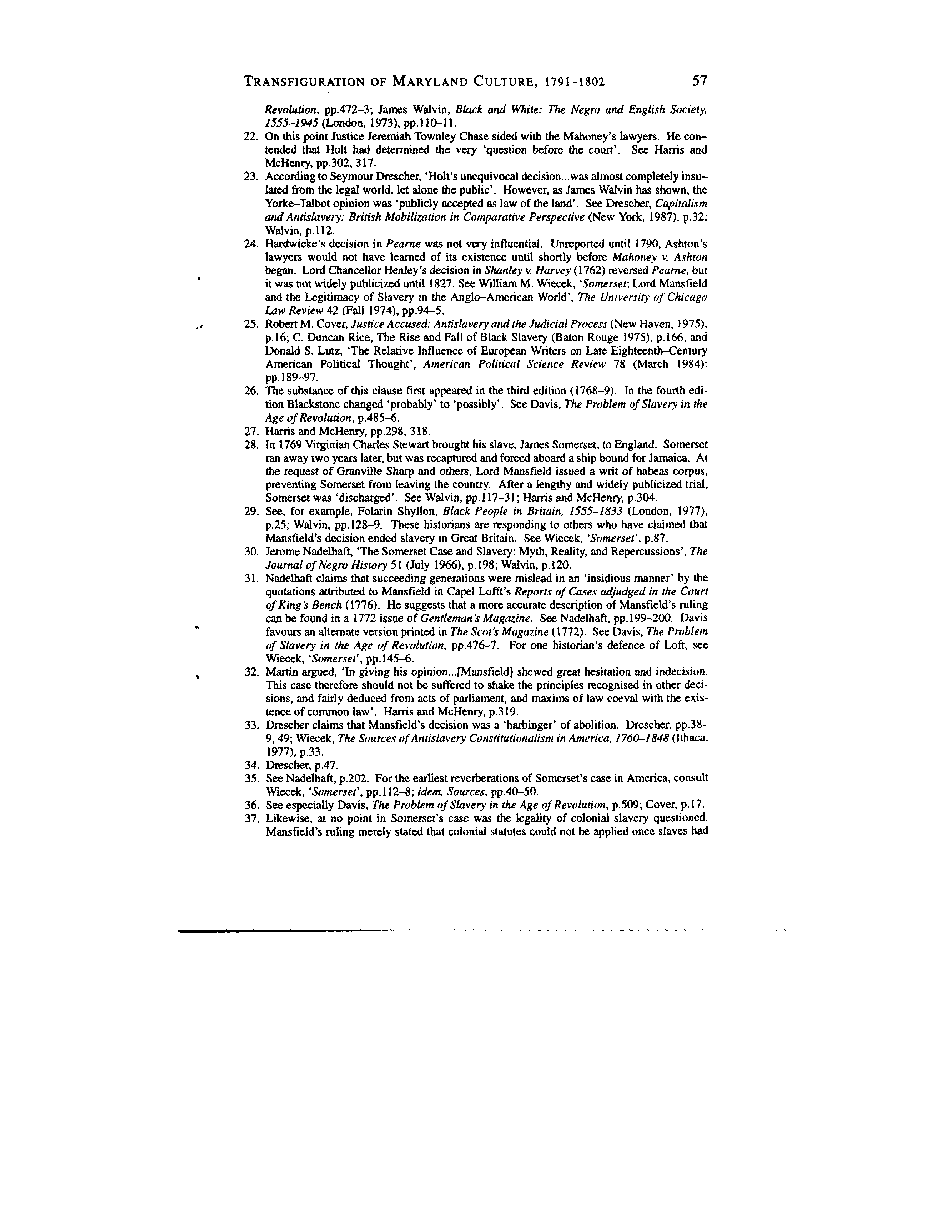|
TRANSFIGURATION OF MARYLAND CULTURE, 1791-1802 57
Revolution, pp.472-3; James Walvin, Black and White: The Negro and English Society,
1555-1945 (London, 1973), pp.110-11.
22. On this point Justice Jeremiah Townley Chase sided with the Mahoney's lawyers. He con-
tended that Holt had determined the very 'question before the court'. See Harris and
McHenry, pp.302, 317.
23. According to Seymour Drescher, 'Holt's unequivocal decision...was almost completely insu-
lated from the legal world, let alone the public'. However, as James Walvin has shown, the
Yorke-Talbot opinion was 'publicly accepted as law of the land'. See Drescher, Capitalism
and Antislavery: British Mobilization in Comparative Perspective (New York, 1987), p.32;
Walvin, p. 112.
24. Hardwicke's decision in Pearne was not very influential. Unreported until 1790, Ashton's
lawyers would not have learned of its existence until shortly before Mahoney v. Ashton
began. Lord Chancellor Henley's decision in Shanley v. Harvey (1762) reversed Pearne, but
it was not widely publicized until 1827. See William M. Wiecek, 'Somerset: Lord Mansfield
and the Legitimacy of Slavery in the Anglo-American World', The University of Chicago
Law Review 42 (Fall 1974), pp.94-5.
25. Robert M. Cover, Justice Accused: Antislavery and the Judicial Process (New Haven, 1975),
p.16; C. Duncan Rice, The Rise and Fall of Black Slavery (Baton Rouge 1975), p.I66; and
Donald S. Lutz, "The Relative Influence of European Writers on Late Eighteenth-Century
American Political Thought', American Political Science Review 78 (March 1984):
pp. 189-97.
26. The substance of this clause first appeared in the third edition (1768-9). In the fourth edi-
tion Blackstone changed 'probably' to 'possibly'. See Davis, The Problem of Slavery in the
Age of Revolution, p.485-6.
27. Harris and McHenry, pp.298, 318.
28. In 1769 Virginian Charles Stewart brought his slave, James Somerset, to England. Somerset
ran away two years later, but was recaptured and forced aboard a ship bound for Jamaica. At
the request of Granville Sharp and others, Lord Mansfield issued a writ of habeas corpus,
preventing Somerset from leaving the country. After a lengthy and widely publicized trial,
Somerset was 'discharged'. See Walvin, pp.117-31; Harris and McHenry, p.304.
29. See, for example, Folarin Shyllon, Black People in Britain, 1555-J 833 (London, 1977),
p.25; Walvin, pp.128-9. These historians are responding to others who have claimed that
Mansfield's decision ended slavery in Great Britain. See Wiecek, 'Somerset', p.87.
30. Jerome Nadelhaft, 'The Somerset Case and Slavery: Myth, Reality, and Repercussions', The
Journal of Negro History 51 (July 1966), p.198; Walvin, p.I20.
31. Nadelhaft claims that succeeding generations were mislead in an 'insidious manner' by the
quotations attributed to Mansfield in Capel Lofft's Reports of Cases adjudged in the Court
of King's Bench (1776). He suggests that a more accurate description of Mansfield's ruling
can be found in a 1772 issue of Gentleman's Magazine. See Nadelhaft, pp. 199-200. Davis
favours an alternate version printed in The Scot's Magazine (1772). See Davis, The Problem
of Slavery in the Age of Revolution, pp.476-7. For one historian's defence of Loft, see
Wiecek, 'Somerset', pp.145-6.
32. Martin argued, 'In giving his opinion...[Mansfield] shewed great hesitation and indecision.
This case therefore should not be suffered to shake the principles recognised in other deci-
sions, and fairly deduced from acts of parliament, and maxims of law coeval with the exis-
tence of common law'. Harris and McHenry, p.319.
33. Drescher claims that Mansfield's decision was a 'harbinger' of abolition. Drescher, pp.38-
9, 49; Wiecek, The Sources of Antislavery Constitutionalism in America, 1760-1848 (Ithaca,
1977), p.33.
34. Drescher, p.47.
35. See Nadelhaft, p.202. For the earliest reverberations of Somerset's case in America, consult
Wiecek, 'Somerset', pp.112-8; idem. Sources, pp.40-50.
36. See especially Davis, The Problem of Slavery in the Age of Revolution, p.509; Cover, p. 17.
37. Likewise, at no point in Somerset's case was the legality of colonial slavery questioned.
Mansfield's ruling merely stated that colonial statutes could not be applied once slaves had
�
|

